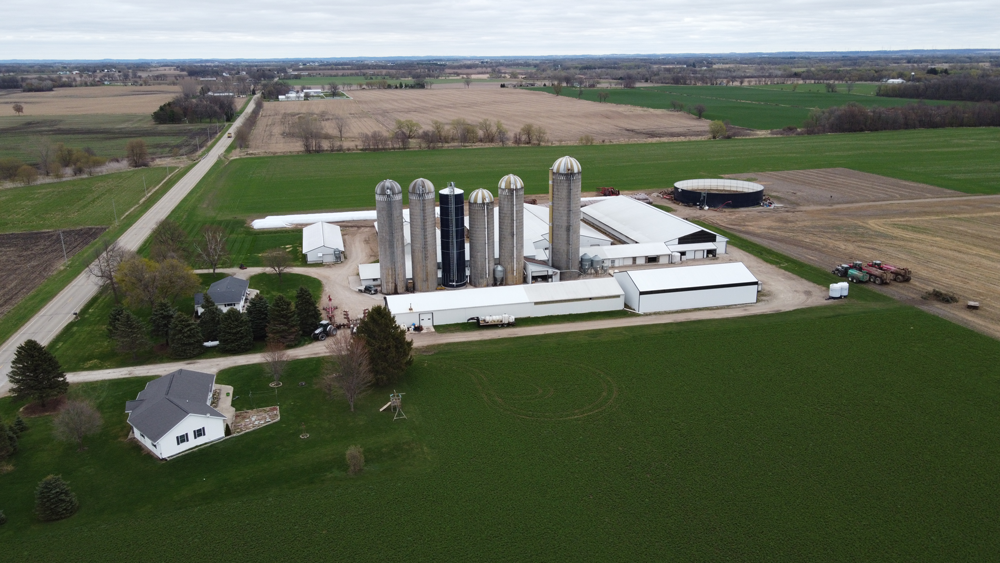Article written by Josh Hiemstra, Hiemstra Dairy LLC
Photos provided by Zach Laughlin, Fond du Lac County LWCD
Hello to all working to make the Fox-Wolf River Basin healthy and more vibrant! I am Josh Hiemstra from Brandon, WI. Together with my wife (Bobbie), children (Mason and Cassandra), and father (Robert) we own and operate Hiemstra Dairy LLC milking 180 Holsteins, finishing 150 Angus x cattle and managing nearly 800 acres of crops.
Our home farm is located within the Upper Rock River Watershed. We have practiced nutrient management, reduced tillage, and cover crop integration for some time.
We started with covers very simply, not really knowing where it would lead or what kind of journey we were going to take. At the time, our farm just simply needed more feed. We seeded cereal rye after silage ahead of soybeans- a real no brainer. Unknowingly, we were stumbling into the next big thing in not only agriculture but on the planet. Farmers are now being observed more closely and are being counted on by everyone we feed to be part of the climate change solution.
For years we moldboard plowed and established alfalfa in the fall. Having sold the plow, we did not succeed with fall alfalfa and changed to corn after wheat with applying liquid manure in the summer after harvest.
It was the worst corn we raised despite rotation and manure. So, looking to have more control of our manure prior to corn we planted tillage radish. The results were poor, stemming from the wrong establishment methods among other things.
Now almost 10 years later we’ve made the mistakes and learned from them. Corn after the cover crop is now the most profitable crop we raise each year. While we continue to learn and trial, we also have clear goals and plans with cover crops. Each crop is planted for a purpose, some with immediate payback and some with long term benefits.
We continue to invest more in our covers. Managing covers like your cash crops will help your cover crop to feed the biology in your soil. More active soil biology helps with increasing nutrient efficiency and managing soil moisture.
I’ve shared our farms short story and now it’s time for you to ask yourselves these questions as you prepare for cover crop establishment this late summer and fall:
- What cash crop are you following?
- Is there any herbicide restriction to consider?
- What are your goals with this cover crop?
- What’s your cash crop to follow?
- How much money or capital do you want to invest in attaining your goal?
- How do you intend to plant your cover(s)?
To help you answer questions 1,2, and 3 about your own farm, the next page describes what we plant after winter wheat harvest at Hiemstra Dairy.
All our mixes are usually custom blended but much of what we use can be bought premixed from companies such as Soil First (Lacrosse seed) or Byron seeds (companies listed as examples, not endorsements). The mixes companies sell are based on the farm’s goals, i.e. forage production, reducing compaction, nutrient scavenging, nitrogen production, and erosion control.
When following wheat, or early harvested canning crops, a good window is available to be diverse. Try to have a grass, legume and brassica if possible and determine what of each type based on the preceding cash crop and next cash crops. We usually plant with forage production as an option although we don’t always harvest it. Most times we use a grain drill for planting the mix together at about 1” depth. Not having legume boxes this still works quite well. Other years we have planted peas and tillage radish in a split row planter using soybean and sugar beet plates respectively. Or broadcast can work with higher seeding rates and light incorporation.
This is a good time to remind everyone to use lower rates with mixes to allow all species to compete. I lower the rate based on how many species, if 2 then 1/2 if 3 then 1/3 of normal individual rates. My preferred mix after wheat:
Forage Peas
Forage peas or any pea type will produce nitrogen and suppress weeds. We use forage for cost and better feed value. There are winter peas that are more frost tolerant and produce more nitrogen but don’t align with our budget or forage goals. Soybeans could be included but are not the best option for forage or cost and the weed suppression isn’t as great either.
Small Grain
Small grains are quick to establish and give the soil good erosion protection and being a grass species sequesters more carbon. We include red clover for a crop that is inexpensive and will over winter, providing nitrogen and green manure in the spring. Keep in mind that we go to corn after wheat. If you were going to beans, cereal rye or rye grass would be a better over winter green option.
Brassicas
Radishes are included to sequester the nutrients from our manure that is applied after wheat is harvested. They can store massive amounts of nutrients that will be available to the following crop. They break compaction, are attractive to deer, and bring more earthworms in. They will help with infiltration after they decompose. Being a brassica, they are hardy and you don’t need much in a mix but planted alone you don’t get much above ground biomass for erosion protection. Other options for brassicas include turnips, rapeseed, kale or mustards.
Sunflowers
We add sunflowers for more diversity above and below ground, to pull up zinc that helps in the next corn crop. I may need a trial with added zinc or sunflower check strips to prove this as I am only going on others data and mostly plant for my wife and others viewing pleasure!
As you can see, we have diversity which is very important to speed up our soil health recharge. Grass covers before legume cash crop and vice versa. Also, for those canning acres or cash grain wheat farmers don’t rule out late summer alfalfa seeding.
You could sell a first cutting of hay in 2022 and plant late sweet corn after or just use it as green manure for a corn crop. Another consideration, especially in 2021, is to plant Sorghum Sudan this summer with a late fall harvest to sell or use as a cover prior to soybeans in 2022. If planting corn after the Sorghum Sudan in 2022, clover or alfalfa could be seeded with it in 2021 for a second forage option in the spring of 2022 or green manure. All of these options are excellent for trading in manure as a nutrient source to replace what the forage harvest will remove. However, if left untouched there is a lot of biomass to manage the following spring, which is good thing. Make sure to have a plan to properly manage it when planting the next crop.

Questions? Contact us:
Climate Smart Agriculture Project Manager: Katie Woodrow, 920.915.5767 or katie@fwwa.org
To receive periodic updates on these projects as well as many others, please subscribe to our newsletters: CLICK HERE








